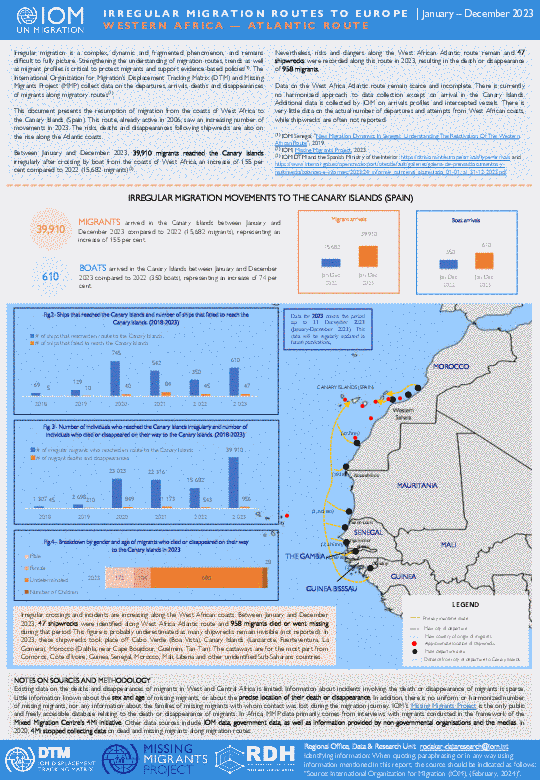-
Countries
-
Data and Analysis
-
Special Focus
-
Crisis Responses
Situation Report

Contact
DTM République Centrafricaine, DTMRCA@iom.int
Language
English
Location
Central African Republic
Period Covered
Dec 02 2023
Jan 09 2024
Activity
- Mobility Tracking
- Baseline Assessment
Ce tableau de bord présente les dynamiques de déplacements à l’échelle nationale. L’évaluation a été réalisée dans 4 410 localités de présence des PDI et / ou retournés et 77 sites de déplacement. La collecte de données s’est tenue entre le 02 décembre 2023 et le 09 janvier 2024 dans les 16 préfectures du pays en plus de la capitale Bangui.j

Contact
DTM South Sudan, SouthSudanDTM@iom.int
Language
English
Location
South Sudan
Period Covered
Aug 31 2021
Oct 14 2021
Activity
- Survey
- Return Intention
1. This report provides field-level data to complement and validate findings from the 2020 Flood Damage and Needs Assessment (FDNA) on the 2020 seasonal floods (June-December) in South Sudan which largely relied on the analysis of remote sensing and geodata. The World Bank tasked IOM to conduct field assessments in three payams (administrative level 3) to collect empirical data from flood-affected areas to verify and substantiate findings from the FDNA.
2. The FDNA Field Validation combines four sources of primary data: two quantitative tools mapping the flood impact and exploring community responses of which one was conducted at the boma level (administrative level 4) and one at a more granular level (facility, livelihood area and settlement level), as well as two qualitative tools of which one is a set of Focus Group Discussions (FGDs) at the boma level and the other is a series of Key Informant Interviews (KIIs) with participants recruited from key stakeholder groups at the national level. IOM interviewed and consulted more than 1,131 individuals for the exercise across all tools.
3. This report provides insights on multiple levels of granularity concerning the 2020 floods in terms of the extent and severity of impact on public infrastructure, shelter, displacement, livelihoods, Health, Water, Hygiene and Sanitation (WASH), and education.
● In terms of infrastructure, findings confirm and illustrate the floods’ debilitating impact on public buildings, roads and livelihood institutions. Some 21 per cent of 709 accessed facilities were found to be dysfunctional. Half of all remaining functional facilities were affected by the floods in 2020. Diminished road access was observed across sectors as communities were unable to access important locations such as healthcare, markets, and educational facilities. Access constraints not only limited movement out of flooded areas, but also prevented aid from reaching populations in need. Impacts on damaged facilities were not only severe (more than 50% reported medium to severe damage) but also protracted (more than 80% of damage facilities were still affected between one and six months later).
● For a population largely dependent on the land, the floods made most forms of livelihood activities impossible. Farmers reported being unable to harvest anything in half of the accessed bomas where farming is practiced. Waterlogged fields meant that farming was rendered impossible long after the rains had stopped, and a lack of harvest made planting in the subsequent season impossible. The analysis also indicates that tensions arose between farmers and cattle keepers, and also among various cattle keeping groups, as a result of flooding on usable land. Communities reported losing a large number of cattle which often drowned or succumbed to diseases that spread after the floods subsided.
● The 2020 floods caused displacement within 11, from 9 and to 9 out of 16 assessed boma. Movements remained localized in most cases, with exceptions in Bor, where population movement was more common across county and state lines. Communities quickly switched from being hosts communities to being hosted by other communities as IDPs, while many struggled to support arriving IDPs because of the additional stress the floods had put on available resources. IOM found that recurrence of flooding and longevity of stagnant water has changed the patterns and temporality of displacement, which after the 2020 flood was often long-term with periods of displacement lasting up to the time of assessment (September 2021) in half of the assessed boma.
● Shelter damage was severe and widespread in all assessed boma. On a settlement level, the FIFIS tool revealed that, with few exceptions, the floods damaged shelters in almost all assessed areas (97% or 63 of 65 flooded settlements). Floods moreover hindered access to common shelter building materials, preventing the rehabilitation of homes. In the majority of settlements, shelters had not been repaired in any way and remained largely inhabitable (56% or 35/63).
● Respondents reported an increase in disease outbreaks, notably malaria upsurges, and a simultaneous decrease in access to healthcare.
Access to education was similarly stressed, most commonly due impassible roads but also damaged educational facilities.
4. This report also explores community-based disaster risk management (CBDRM) in South Sudan, with a focus on identifying current capacities at the local level, and gaps that stakeholders can address through strategic support and programming. In line with South Sudan’s nascent National Disaster Risk Management Policy, and the recurrence of devastating floods and the heightened vulnerability of communities to climate-related shocks, , government, humanitarians and development partners are seeking to strengthen disaster preparedness and response across the country, including at the community level. The analysis shows a range of ad hoc CBDRM initiatives, primarily through the form of mobilization to build dykes using local materials, the establishment of disaster risk management committees, and mobilization to safe areas. Additionally, while women and youth often bear tremendous responsibility in flood-affected communities, including caring for vulnerable household members, as well as building and maintaining dykes, they continue to be marginalized in local decision-making. Local and indigenous knowledge is often used as one mechanism for communities to anticipate and prepare for floods, however this knowledge has not been integrated into early warning systems and formal coordination mechanisms developed by partners and government institutions. Key gaps were identified in terms of coordination amongst partners and government stakeholders, as CBDRM mechanisms continue to operate at an ad hoc level. Lastly, compounding factors have made it challenging for stakeholders to support CBDRM initiatives, particularly in relation to inter-communal violence and displacement.
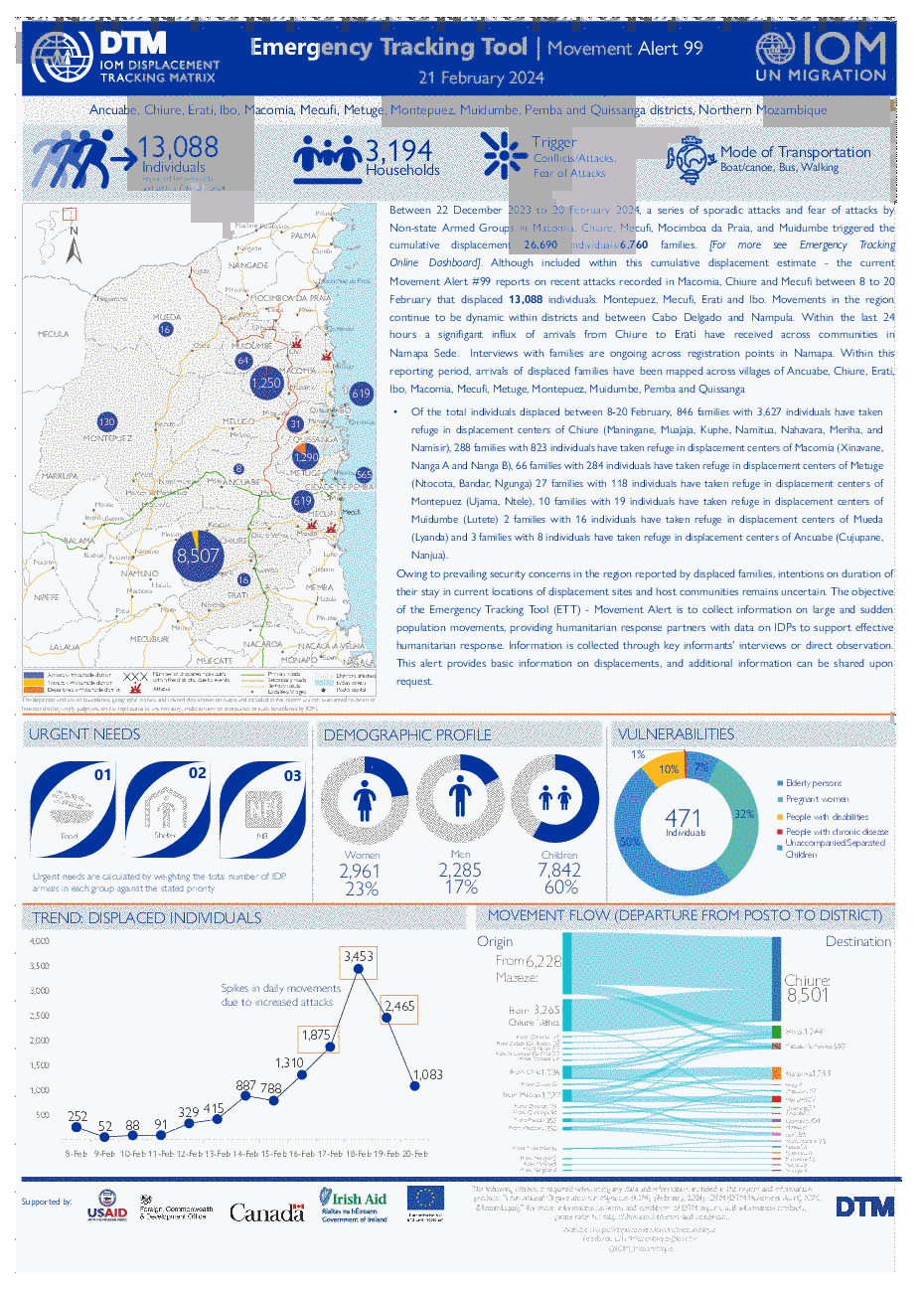
Contact
DTMMozambique@iom.int
Language
English
Location
Mozambique
Period Covered
Feb 08 2024
Feb 20 2024
Activity
- Mobility Tracking
Between 22 December 2023 to 20 February 2024, a series of sporadic attacks and fear of attacks by Non-state Armed Groups in Macomia, Chiure, Mecufi, Mocimboa da Praia, and Muidumbe triggered the cumulative displacement 26,690 individuals/6,760 families. [For more see Emergency Tracking Online Dashboard]. Although included within this cumulative displacement estimate - the current Movement Alert #99 reports on recent attacks recorded in Macomia, Chiure and Mecufi between 8 to 20 February that displaced 13,088 individuals. Montepuez, Mecufi, Erati and Ibo. Movements in the region continue to be dynamic within districts and between Cabo Delgado and Nampula. Within the last 24 hours a significant influx of arrivals from Chiure to Nampula have received across communities in Namapa Sede. Interviews with families are ongoing across registration points in Namapa. Within this reporting period, arrivals of displaced families have been mapped across villages of Ancuabe, Chiure, Erati, Ibo, Macomia, Mecufi, Metuge, Montepuez, Muidumbe, Pemba and Quissanga.
Irregular migration is a complex, dynamic and fragmented phenomenon, and remains difficult to fully picture. Strengthening the understanding of migration routes, trends as well as migrant profiles is critical to protect migrants and support evidence-based policies. The International Organization for Migration's Displacement Tracking Matrix (DTM) and Missing Migrants Project (MMP) collect data on the departures, arrivals, deaths and disappearances of migrants along migratory routes.
This document presents the resumption of migration from the coasts of West Africa to the Canary Islands (Spain). This route, already active in 2006, saw an increasing number of movements in 2023. The risks, deaths and disappearances following shipwrecks are also on the rise along the Atlantic coasts.
Between January and December 2023, 39,910 migrants reached the Canary Islands irregularly after crossing by boat from the coasts of West Africa, an increase of 155 per cent compared to 2022 (15,682 migrants).
Nevertheless, risks and dangers along the West African Atlantic route remain and 47 shipwrecks were recorded along this route in 2023, resulting in the death or disappearance of 958 migrants.
Data on the West Africa Atlantic route remain scarce and incomplete. There is currently no harmonized approach to data collection except on arrival in the Canary Islands. Additional data is collected by IOM on arrivals profiles and intercepted vessels. There is very little data on the actual number of departures and attempts from West African coasts, while shipwrecks are often not reported.
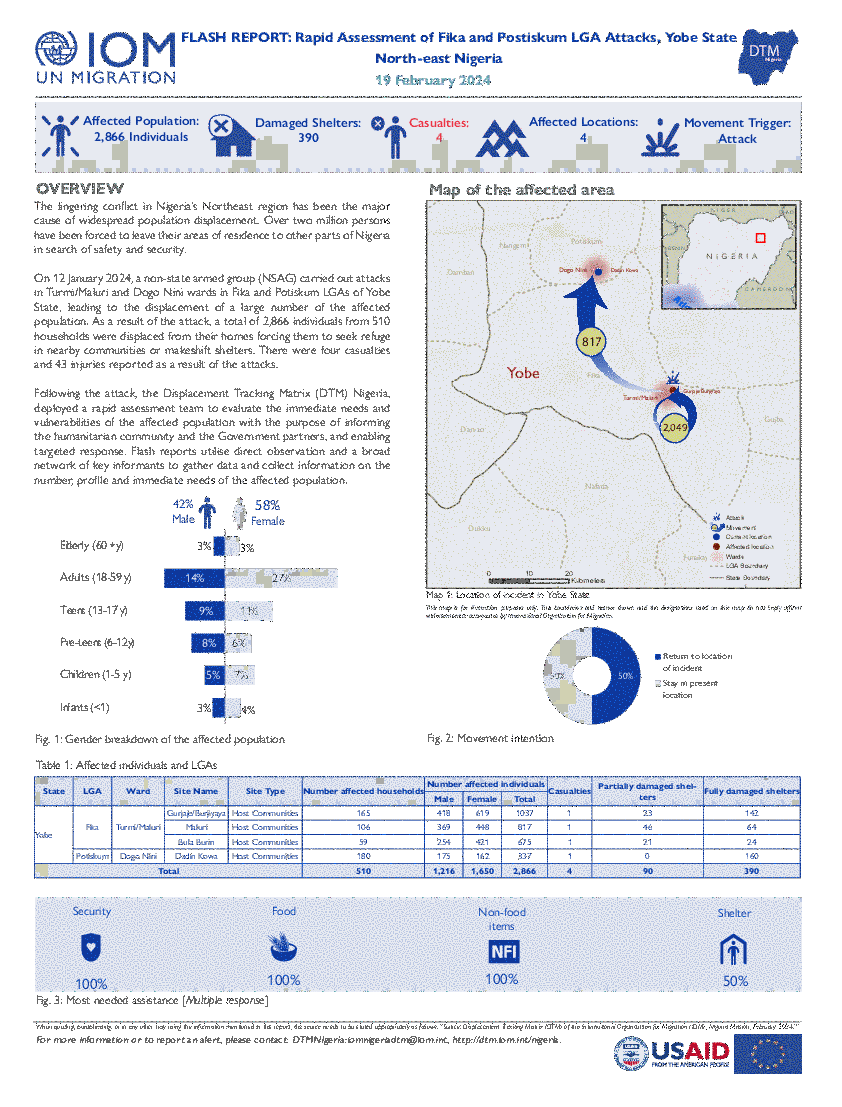
Contact
DTM Nigeria, iomnigeriadtm@iom.int
Language
English
Location
Nigeria
Snapshot Date
Feb 12 2024
Activity
- Mobility Tracking
- Event Tracking
On 12 January 2024, a non-state armed group (NSAG) carried out attacks in Turmi/Maluri and Dogo Nini wards in Fika and Potiskum LGAs of Yobe State, leading to the displacement of a large number of the affected population. As a result of the attack, a total of 2,866 individuals from 510 households were displaced from their homes forcing them to seek refuge in nearby communities or makeshift shelters. There were four casualties and 43 injuries reported as a result of the attacks.
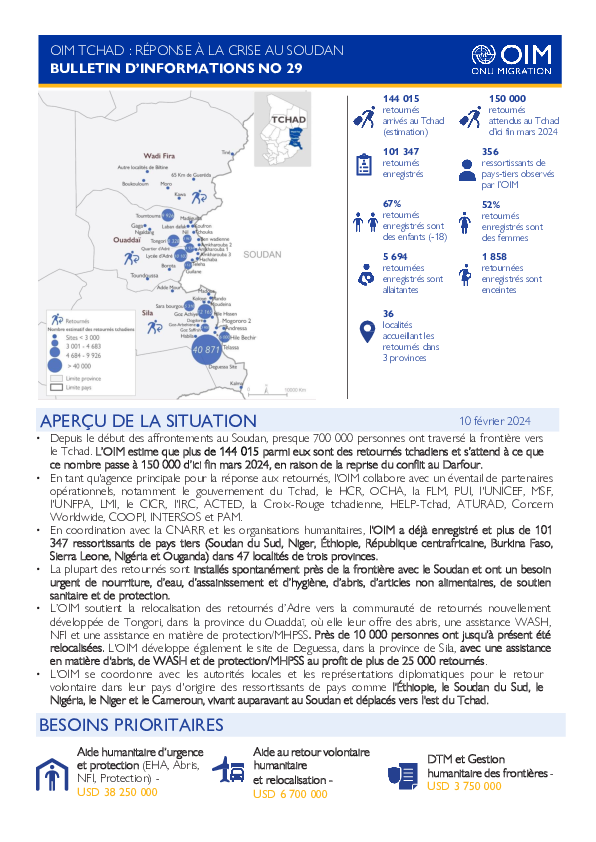
Contact
DTM Chad, dtmtchad@iom.int
Language
French
Location
Chad
Period Covered
Feb 10 2024
Feb 10 2024
Activity
- Mobility Tracking
- Event Tracking
• Depuis le début des affrontements au Soudan, presque 700 000 personnes ont traversé la frontière vers le Tchad. L’OIM estime que plus de 144 015 parmi eux sont des retournés tchadiens et s’attend à ce que ce nombre passe à 150 000 d’ici fin mars 2024, en raison de la reprise du conflit au Darfour.
• En tant qu'agence principale pour la réponse aux retournés, l'OIM collabore avec un éventail de partenaires opérationnels, notamment le gouvernement du Tchad, le HCR, OCHA, la FLM, PUI, l'UNICEF, MSF, l'UNFPA, LMI, le CICR, l'IRC, ACTED, la Croix-Rouge tchadienne, HELP-Tchad, ATURAD, Concern Worldwide, COOPI, INTERSOS et PAM.
• En coordination avec la CNARR et les organisations humanitaires, l'OIM a déjà enregistré et plus de 101 347 ressortissants de pays tiers (Soudan du Sud, Niger, Éthiopie, République centrafricaine, Burkina Faso, Sierra Leone, Nigéria et Ouganda) dans 47 localités de trois provinces.
• La plupart des retournés sont installés spontanément près de la frontière avec le Soudan et ont un besoin urgent de nourriture, d’eau, d’assainissement et d’hygiène, d’abris, d’articles non alimentaires, de soutien sanitaire et de protection.
• L’OIM soutient la relocalisation des retournés d’Adre vers la communauté de retournés nouvellement développée de Tongori, dans la province du Ouaddaï, où elle leur offre des abris, une assistance WASH, NFI et une assistance en matière de protection/MHPSS. Près de 10 000 personnes ont jusqu’à présent été relocalisées. L'OIM développe également le site de Deguessa, dans la province de Sila, avec une assistance en matière d'abris, de WASH et de protection/MHPSS au profit de plus de 25 000 retournés.
• L'OIM se coordonne avec les autorités locales et les représentations diplomatiques pour le retour volontaire dans leur pays d'origine des ressortissants de pays comme l'Éthiopie, le Soudan du
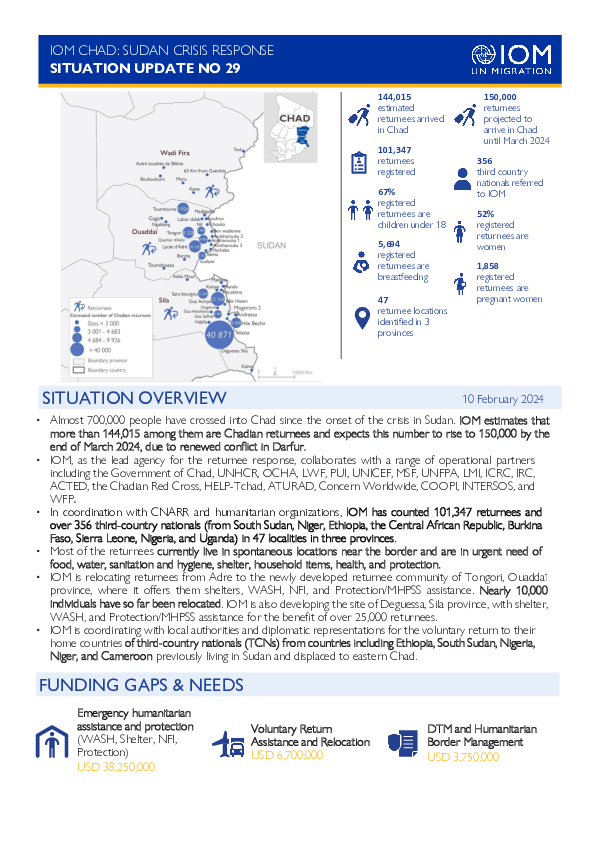
Contact
DTM Chad, dtmtchad@iom.int
Language
English
Location
Chad
Period Covered
Feb 12 2024
Feb 12 2024
Activity
- Mobility Tracking
- Event Tracking
• Almost 700,000 people have crossed into Chad since the onset of the crisis in Sudan. IOM estimates that more than 144,015 among them are Chadian returnees and expects this number to rise to 150,000 by the end of March 2024, due to renewed conflict in Darfur.
• IOM, as the lead agency for the returnee response, collaborates with a range of operational partners including the Government of Chad, UNHCR, OCHA, LWF, PUI, UNICEF, MSF, UNFPA, LMI, ICRC, IRC, ACTED, the Chadian Red Cross, HELP-Tchad, ATURAD, Concern Worldwide, COOPI, INTERSOS, and WFP.
• In coordination with CNARR and humanitarian organizations, IOM has counted 101,347 returnees and over 356 third-country nationals (from South Sudan, Niger, Ethiopia, the Central African Republic, Burkina Faso, Sierra Leone, Nigeria, and Uganda) in 47 localities in three provinces.
• Most of the returnees currently live in spontaneous locations near the border and are in urgent need of food, water, sanitation and hygiene, shelter, household items, health, and protection.
• IOM is relocating returnees from Adre to the newly developed returnee community of Tongori, Ouaddaï province, where it offers them shelters, WASH, NFI, and Protection/MHPSS assistance. Nearly 10,000 individuals have so far been relocated. IOM is also developing the site of Deguessa, Sila province, with shelter, WASH, and Protection/MHPSS assistance for the benefit of over 25,000 returnees.
• IOM is coordinating with local authorities and diplomatic representations for the voluntary return to their home countries of third-country nationals (TCNs) from countries including Ethiopia, South Sudan, Nigeria, Niger, and Cameroon previously living in Sudan and displaced to eastern Chad.
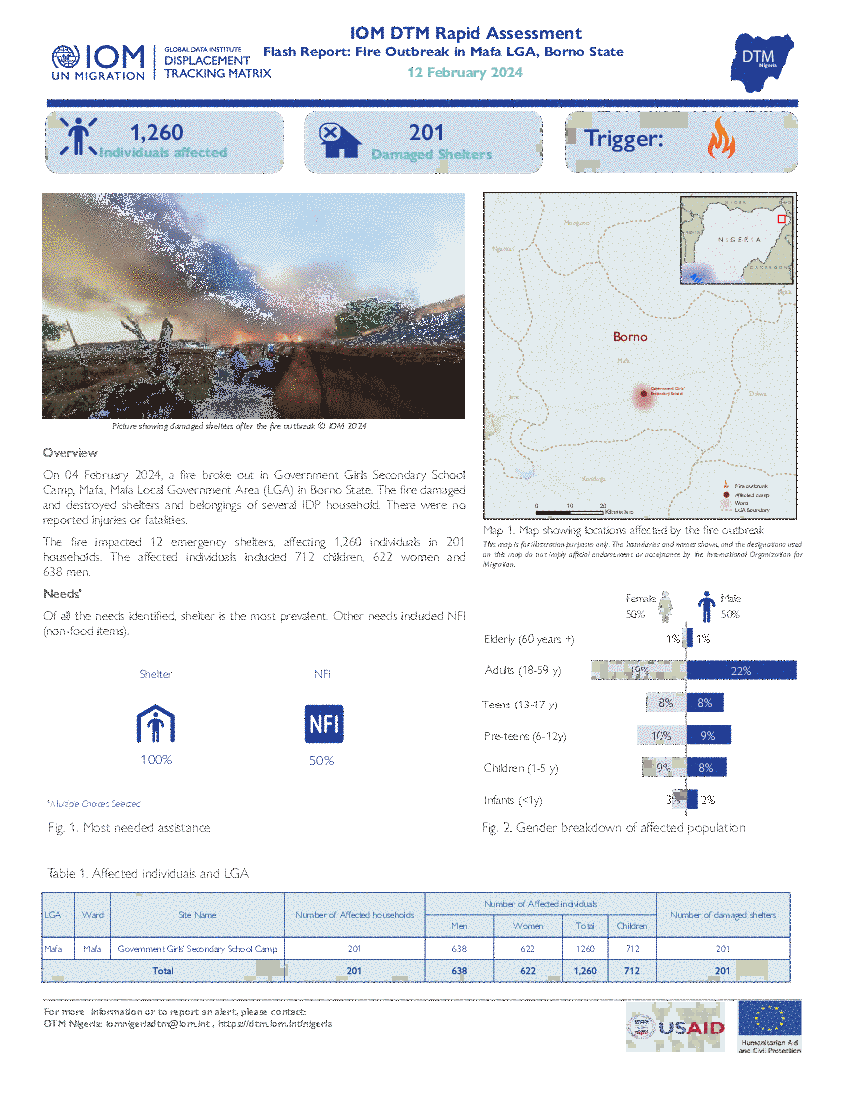
Contact
DTM Nigeria, iomnigeriadtm@iom.int
Language
English
Location
Nigeria
Snapshot Date
Feb 04 2024
Activity
- Mobility Tracking
- Event Tracking
On 04 February 2024, a fire broke out in Government Girls Secondary School Camp, Mafa, Mafa Local Government Area (LGA) in Borno State. The fire damaged and destroyed shelters and belongings of several IDP household. There were no reported injuries or fatalities.
The fire impacted 12 emergency shelters, affecting 1,260 individuals in 201 households. The affected individuals included 712 children, 622 women and 638 men.

Contact
DTM Nigeria, iomnigeriadtm@iom.int
Language
English
Location
Nigeria
Period Covered
Feb 06 2024
Feb 07 2024
Activity
- Mobility Tracking
- Event Tracking
On 06 and 07 February 2024, fires broke out in GSSSS camp Monguno, and Mashamari Kuluye camp of Konduga Local Government Area (LGA) of Borno State, which destroyed the shelters and possessions of many Internally Displaced Persons (IDPs). Many personal items have been lost in the fire, including food items and non-food items. Three fatalities were reported after the incident.
The fire destroyed 58 self-made/makeshift shelters affecting 391 individuals in 58 households. The affected individuals included 223 children, 88 women and 80 men.
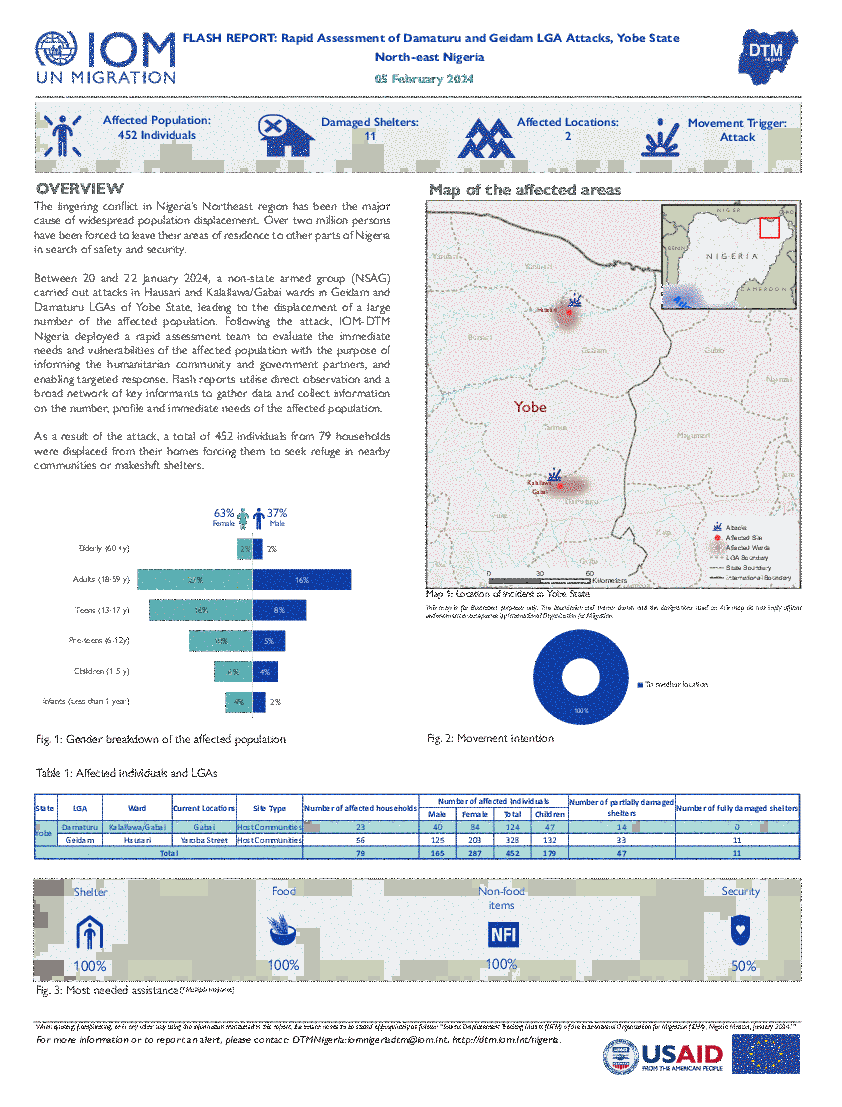
Contact
DTM Nigeria, iomnigeriadtm@iom.int
Language
English
Location
Nigeria
Period Covered
Jan 20 2024
Jan 22 2024
Activity
- Mobility Tracking
- Event Tracking
Between 20 and 22 January 2024, a non-state armed group (NSAG) carried out attacks in Hausari and Kalallawa/Gabai wards in Geidam and Damaturu LGAs of Yobe State, leading to the displacement of a large number of the affected population.
As a result of the attack, a total of 452 individuals from 79 households were displaced from their homes forcing them to seek refuge in nearby communities or makeshift shelters.
Pagination
- Previous page
- Page 17
- Next page
